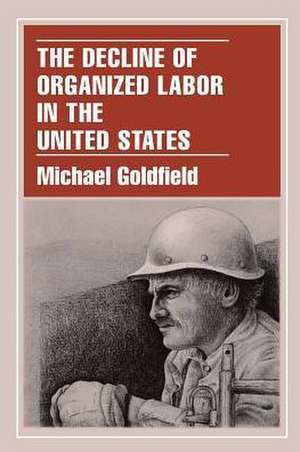The Decline of Organized Labor in the United States
Autor Michael Goldfielden Limba Engleză Paperback – 30 apr 1989
Michael Goldfield challenges standard explanations for union decline, arguing that the major causes are to be found in the changing relations between classes. Goldfield combines innovative use of National Labor Relations Board certification election data, which serve as an accurate measure of new union growth in the private sector, with a sophisticated analysis of the standard explanations of union decline. By understanding the decline of U.S. labor unions, he maintains, it is possible to begin to understand the conditions necessary for their future rebirth and resurgence.
Preț: 266.29 lei
Nou
Puncte Express: 399
Preț estimativ în valută:
50.96€ • 55.34$ • 42.81£
50.96€ • 55.34$ • 42.81£
Carte tipărită la comandă
Livrare economică 22 aprilie-06 mai
Preluare comenzi: 021 569.72.76
Specificații
ISBN-13: 9780226301037
ISBN-10: 0226301036
Pagini: 312
Dimensiuni: 152 x 229 x 23 mm
Greutate: 0.36 kg
Ediția:1
Editura: University of Chicago Press
Colecția University of Chicago Press
ISBN-10: 0226301036
Pagini: 312
Dimensiuni: 152 x 229 x 23 mm
Greutate: 0.36 kg
Ediția:1
Editura: University of Chicago Press
Colecția University of Chicago Press
Notă biografică
Michael Goldfield is assistant professor of government at Cornell University.
Cuprins
List of Tables
List of Figures
Acknowledgments
Introduction
Part 1. Organized Labor in the United States: Its General Weakness and Recent Decline
1. Introducing the Decline
2. National Political Influence
3. The Collective Bargaining System
Part 2. The Significance and Meaning of Union Decline
4. The Significance of the Trade Union Debate
5. The Components of Union Decline and the Importance of New Organizing
6. Possible Explanations for the Decline
Part 3. Reasons Behind the Trade Union Decline
7. The Interrogation of the First Suspect: Changes in the Economic Structure and Social Composition of the Work Force
8. A Preliminary Investigation into Cyclical Trends in New Union Organizing
9. The Continuing Search for the Real Culprits: The Relation of Class Forces
Part 4. Conclusion
10. Summary
11. Some Speculations
Appendixes
A. The Data
B. The Cross-sectional Models
C. Pooling of Cross-section and Time-series Data Models
D. The Yearly Aggregate Data
Bibliography
Index
List of Figures
Acknowledgments
Introduction
Part 1. Organized Labor in the United States: Its General Weakness and Recent Decline
1. Introducing the Decline
2. National Political Influence
3. The Collective Bargaining System
Part 2. The Significance and Meaning of Union Decline
4. The Significance of the Trade Union Debate
5. The Components of Union Decline and the Importance of New Organizing
6. Possible Explanations for the Decline
Part 3. Reasons Behind the Trade Union Decline
7. The Interrogation of the First Suspect: Changes in the Economic Structure and Social Composition of the Work Force
8. A Preliminary Investigation into Cyclical Trends in New Union Organizing
9. The Continuing Search for the Real Culprits: The Relation of Class Forces
Part 4. Conclusion
10. Summary
11. Some Speculations
Appendixes
A. The Data
B. The Cross-sectional Models
C. Pooling of Cross-section and Time-series Data Models
D. The Yearly Aggregate Data
Bibliography
Index














